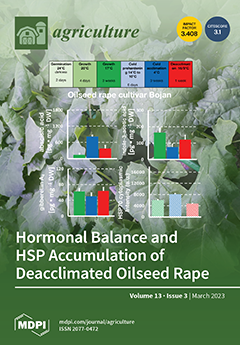In natural habitats, there is a strong evolutionary selection pressure on herbivorous insects to avoid danger and choose suitable host plants. Similar selection pressures may drive movement and choices of oviposition hosts by herbivorous insects living in agricultural cropping systems, in which insecticides are often used. In this study, we quantified movement responses and nymph emergence (collectively referred to as bio-responses) of western-tarnished plant bug (
Lygus hesperus Knight (Hemiptera: Miridae)) individuals when exposed to environments associated with a perceived “risk” (experimental insecticide treatments and their corresponding controls). We introduce a novel analytical approach in which treatments (risk environments) are ranked in ascending order based on bio-responses (movement or nymph emergence). Consequently, linear regression coefficients were generated and used to interpret bio-responses of
Lygus individuals in different life stages to risk environments. Initially, we predicted movement by
Lygus individuals to be positively associated with environmental risk and nymph emergence to be negatively associated with environmental risk. Overall, based on a comprehensive combination of no- and two-choice bioassays, we found that: (1) In no-choice bioassays, movement parameters (both total distance moved and movement percentage) by all three life stages were lowest in low-risk environments and highest when
Lygus individuals were exposed to either malathion or Grandevo. Accordingly, environments involving malathion or Grandevo were considered high-risk. (2) No-choice movement bioassays also revealed that
Lygus males moved significantly more (based on comparison of regression intercepts) than other life stages, and that they responded significantly more (based on comparison of regression slopes) than conspecific females and nymphs. (3) In two-choice movement bioassays, neem elicited the most consistent movement responses by
Lygus individuals, and adult life stages showed the strongest response. Two-choice movement bioassays also revealed that
Lygus adults, compared to nymphs, were more likely to spend time in low-risk areas of the test arenas. (4) Nymph emergence was markedly lower in no-choice compared to two-choice bioassays, and in two-choice bioassays, Grandevo and malathion elicited especially biased nymph emergence from low-risk beans. To our knowledge, this is the first study in which movement bioassays have been used to quantify and characterize behavioral responses by
Lygus life stages to environments associated with varying degrees of risk. The novel analytical approach presented in this study provides a high degree of complementarity to more traditional performance-testing methods used to evaluate responses to insecticides. Furthermore, we believe that this analytical approach can be of considerable relevance to studies of animal phenomics and behavioral studies of animals more broadly, in which adaptation and fitness parameters are examined in response to environmental risk and heterogeneity.
Full article





